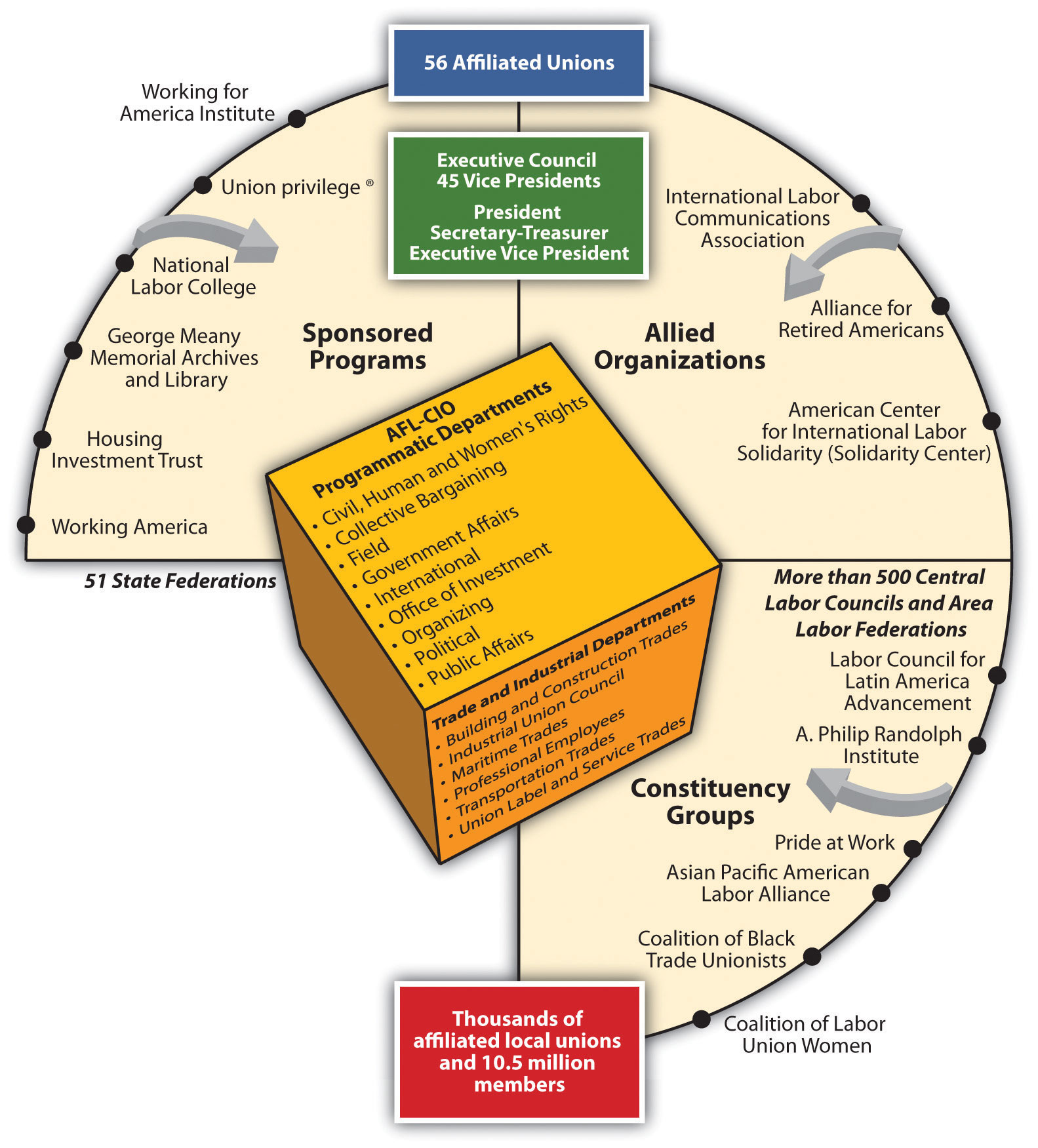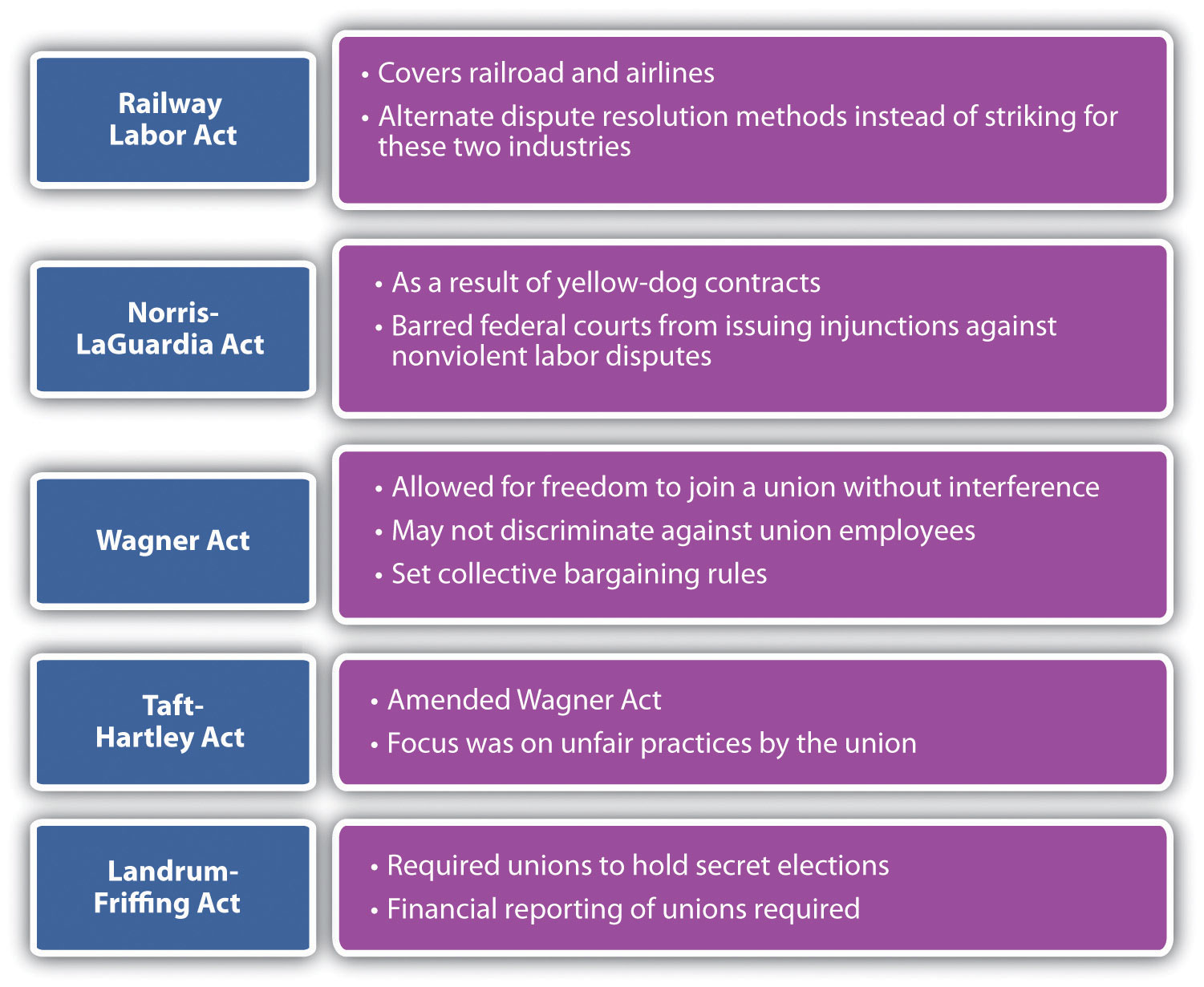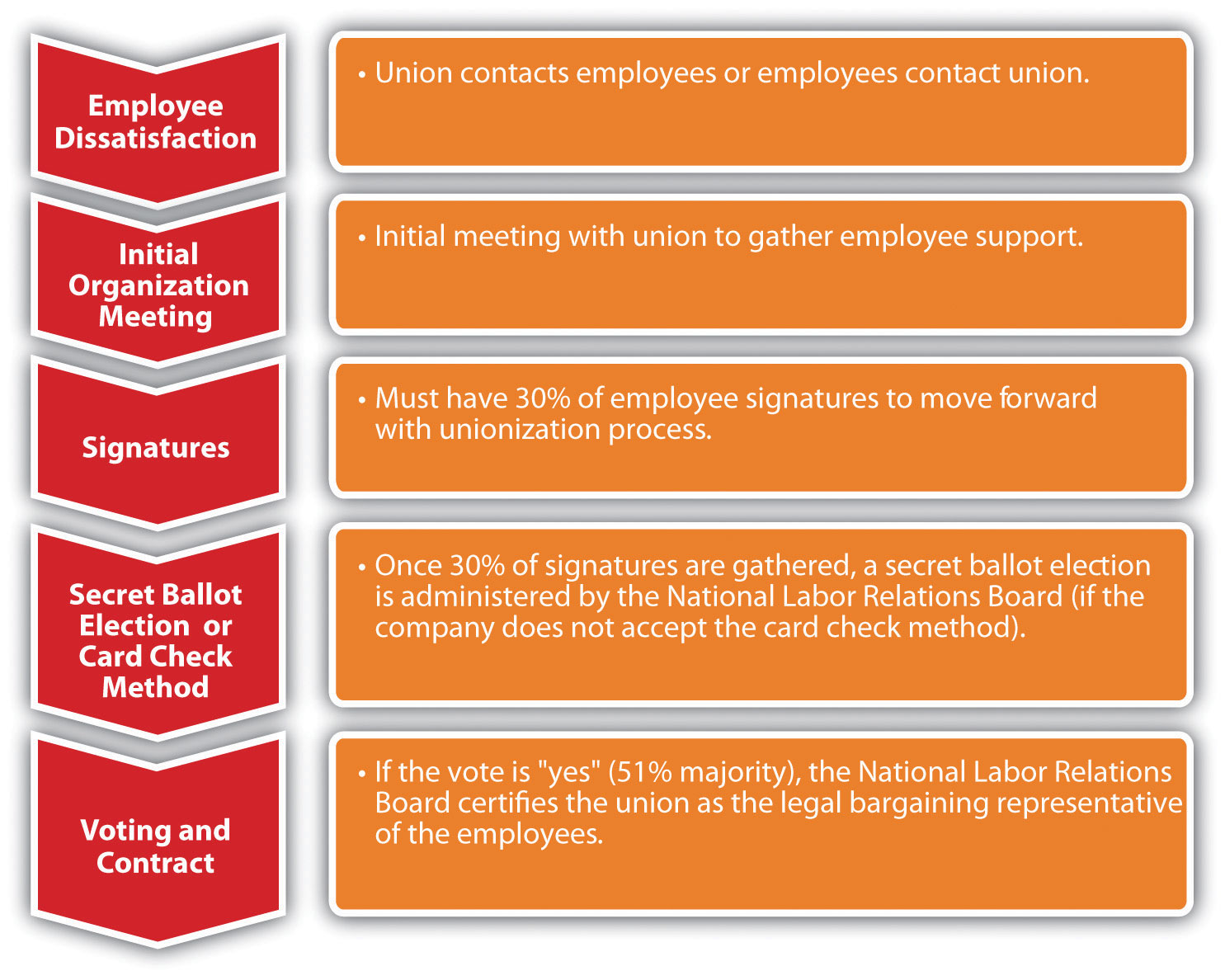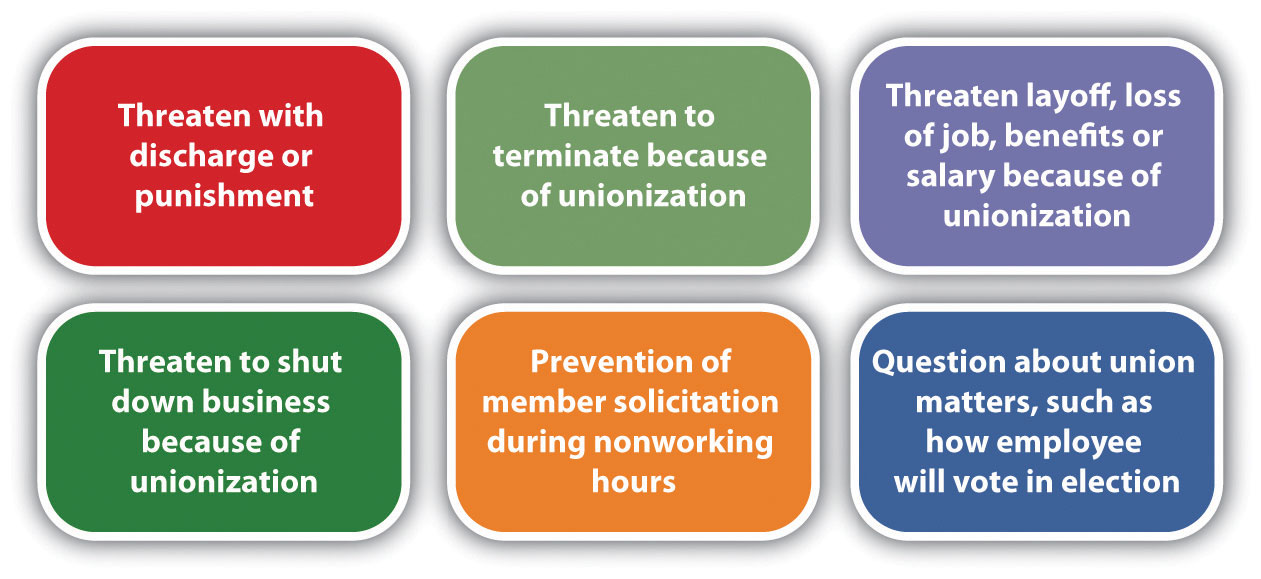A labor unionA group of workers who band together to meet common goals, such as better pay, benefits, or promotion rules., or union, is defined as workers banding together to meet common goals, such as better pay, benefits, or promotion rules. In the United States, 11.9 percent of American workers belong to a union, down from 20.1 percent in 1983.“Union Members: 2010,” Bureau of Labor Statistics, US Department of Labor, news release, January 21, 2011, accessed April 4, 2011, http://www.bls.gov/news.release/pdf/union2.pdf. In this section, we will discuss the history of unions, reasons for decline in union membership, union labor laws, and the process employees go through to form a union. First, however, we should discuss some of the reasons why people join unions.
People may feel their economic needs are not being met with their current wages and benefits and believe that a union can help them receive better economic prospects. Fairness in the workplace is another reason why people join unions. They may feel that scheduling, vacation time, transfers, and promotions are not given fairly and feel that a union can help eliminate some of the unfairness associated with these processes. Let’s discuss some basic information about unions before we discuss the unionization process.
Trade unions were developed in Europe during the Industrial Revolution, when employees had little skill and thus the entirety of power was shifted to the employer. When this power shifted, many employees were treated unfairly and underpaid. In the United States, unionization increased with the building of railroads in the late 1860s. Wages in the railroad industry were low and the threat of injury or death was high, as was the case in many manufacturing facilities with little or no safety laws and regulations in place. As a result, the Bortherhood of Locomotive Engineers and several other brotherhoods (focused on specific tasks only, such as conductors and brakemen) were formed to protect workers’ rights, although many workers were fired because of their membership.
A video from the AFL-CIO shows a history of labor unions, from its perspective.
The first local unions in the United States were formed in the eighteenth century, in the form of the National Labor Union (NLU).
The National Labor Union, formed in 1866, paved the way for other labor organizations. The goal of the NLU was to form a national labor federation that could lobby government for labor reforms on behalf of the labor organizations. Its main focus was to limit the workday to eight hours. While the NLU garnered many supporters, it excluded Chinese workers and only made some attempts to defend the rights of African-Americans and female workers. The NLU can be credited with the eight-hour workday, which was passed in 1862. Because of a focus on government reform rather than collective bargaining, many workers joined the Knights of Labor in the 1880s.
The Knights of Labor started as a fraternal organization, and when the NLU dissolved, the Knights grew in popularity as the labor union of choice. The Knights promoted the social and cultural spirit of the worker better than the NLU had. It originally grew as a labor union for coal miners but also covered several other types of industries. The Knights of Labor initiated strikes that were successful in increasing pay and benefits. When this occurred, membership increased. After only a few years, though, membership declined because of unsuccessful strikes, which were a result of a too autocratic structure, lack of organization, and poor management. Disagreements between members within the organization also caused its demise.
The American Federation of Labor (AFL) was formed in 1886, mostly by people who wanted to see a change from the Knights of Labor. The focus was on higher wages and job security. Infighting among union members was minimized, creating a strong organization that still exists today. In the 1930s, the Congress of Industrial Organizations (CIO) was formed as a result of political differences in the AFL. In 1955, the two unions joined together to form the AFL-CIO.
Currently, the AFL-CIO is the largest federation of unions in the United States and is made up of fifty-six national and international unions. The goal of the AFL-CIO isn’t to negotiate specific contracts for employees but rather to support the efforts of local unions throughout the country.
Currently in the United States, there are two main national labor unions that oversee several industry-specific local unions. There are also numerous independent national and international unions that are not affiliated with either national union:
The national union plays an important role in legislative changes, while the local unions focus on collective bargaining agreements and other labor concerns specific to the area. Every local union has a union stewardAn elected person with the organization who represents the interests of union members. who represents the interests of union members. Normally, union stewards are elected by their peers.
A national union, besides focusing on legislative changes, also does the following:
1. Lobbies in government for worker rights laws
2. Resolves disputes between unions
3. Helps organize national protests
4. Works with allied organizations and sponsors various programs for the support of unions
For example, in 2011, the national Teamsters union organized demonstrations in eleven states to protest the closing of an Ontario, California, parts distribution center. Meanwhile, Teamster Local 495 protested at the Ontario plant.“Teamsters Escalate BMW Protests across America,” PR Newswire, August 2, 2011, accessed August 15, 2011, http://www.teamster.org/content/teamsters-escalate-bmw-protests-across-america.
Figure 12.1 The Complicated Structure of AFL-CIO

Source: AFL-CIO.
The labor movement is currently experiencing several challenges, including a decrease in union membership, globalization, and employers’ focus on maintaining nonunion status. As mentioned in the opening of this section, the United States has seen a steady decline of union membership since the 1950s. In the 1950s, 36 percent of all workers were unionized,Gerald Friedman, “Labor Unions in the United States,” Economic History Association, February 2, 2010, accessed April 4, 2011, http://eh.net/encyclopedia/article/friedman.unions.us. as opposed to just over 11 percent today.
When you are hired for your first job or your next job, do you think you would prefer to be part of a union or not?
Claude Fischer, a researcher from University of California Berkeley, believes the shift is cultural. His research says the decline is a result of American workers preferring individualism as opposed to collectivism.Claude Fischer, , “Why Has Union Membership Declined?” Economist’s View, September 11, 2010, accessed April 11, 2011, http://economistsview.typepad.com/economistsview/2010/09/why-has-union-membership-declined.html. Other research says the decline of unions is a result of globalization, and the fact that many jobs that used to be unionized in the manufacturing arena have now moved overseas. Other reasoning points to management, and that its unwillingness to work with unions has caused the decline in membership. Others suggest that unions are on the decline because of themselves. Past corruption, negative publicity, and hard-line tactics have made joining a union less favorable.
To fully understand unions, it is important to recognize the global aspect of unions. Statistics on a worldwide scale show unions in all countries declining but still healthy in some countries. For example, in eight of the twenty-seven European Union member states, more than half the working population is part of a union. In fact, in the most populated countries, unionization rates are still at three times the unionization rate of the United States.Federation of European Employers, “Trade Unions across Europe,” accessed April 4, 2011, http://www.fedee.com/tradeunions.html. Italy has a unionization rate of 30 percent of all workers, while the UK has 29 percent, and Germany has a unionization rate of 27 percent.
In March 2011, Wisconsin governor Scott Walker proposed limiting the collective bargaining rights of state workers to save a flailing budget. Some called this move “union busting” and said this type of act is illegal, as it takes away the basic rights of workers. The governor defended his position by saying there is no other choice, since the state is in a budget crisis. Other states such as Ohio are considering similar measures. Whatever happens, there is a clear shift for unions today.
Globalization is also a challenge in labor organizations today. As more and more goods and services are produced overseas, unions lose not only membership but union values in the stronghold of worker culture. As globalization has increased, unions have continued to demand more governmental control but have been only somewhat successful in these attempts. For example, free trade agreements such as the North American Free Trade Agreement (NAFTA) have made it easier and more lucrative for companies to manufacture goods overseas. This is discussed in Chapter 14 "International HRM". For example, La-Z-Boy and Whirlpool closed production facilities in Dayton and Cleveland, Ohio, and built new factories in Mexico to take advantage of cheaper labor and less stringent environmental standards. Globalization creates options for companies to produce goods wherever they think is best to produce them. As a result, unions are fighting the globalization trend to try and keep jobs in the United States.
There are a number of reasons why companies do not want unions in their organizations, which we will discuss in greater detail later. One of the main reasons, however, is increased cost and less management control. As a result, companies are on a quest to maintain a union-free work environment. In doing so, they try to provide higher wages and benefits so workers do not feel compelled to join a union. Companies that want to stay union free constantly monitor their retention strategies and policies.
The Railway Labor Act (RLA)Passed in 1926, the act applies to railroads and airlines. The goal of the act is to ensure no disruption of interstate commerce. of 1926 originally applied to railroads and in 1936 was amended to cover airlines. The act received support from both management and unions. The goal of the act is to ensure no disruption of interstate commerce. The main provisions of the act include alternate dispute resolution, arbitration, and mediation to resolve labor disputes. Any dispute must be resolved in this manner before a strike can happen. The RLA is administered by the National Mediation Board (NMB), a federal agency, and outlines very specific and detailed processes for dispute resolution in these industries.
The Norris-LaGuardia ActPassed in 1932 (also known as the anti-injunction bill) this act barred federal courts from issuing injunctions against nonviolent labor disputes and barred employers from interfering with workers joining a union. of 1932 (also known as the anti-injunction bill), barred federal courts from issuing injunctions (a court order that requires a party to do something or refrain from doing something) against nonviolent labor disputes and barred employers from interfering with workers joining a union. The act was a result of common yellow-dog contractsBefore the Norris-LaGuardia Act, contracts in which a worker agreed to not join a union before accepting a job., in which a worker agreed not to join a union before accepting a job. The Norris-LaGuardia Act made yellow-dog contracts unenforceable in courts and established that employees were free to join unions without employer interference.
In 1935, the Wagner ActA law passed in 1935 that changed the way employers can react to several aspects of unions and unionization. (sometimes called the National Labor Relations Act) was passed, changing the way employers can react to several aspects of unions. The Wagner Act had a few main aspects:
The National Labor Relations Board (NLRB)The organization that oversees and enforces the Wagner and Taft-Hartley acts. It handles unfair labor practice complaints and facilitates unionization efforts. oversees this act, handling any complaints that may arise from the act. For example, in April 2011, the NLRB worked with employees at Ozburn-Hessey Logistics in Tennessee after they had been fired because of their involvement in forming a union. The company was also accused of interrogating employees about their union activities and threatened employees with loss of benefits should they form a union. The NLRB utilized their attorney to fight on behalf of the employees, and a federal judge ordered the company to rehire the fired employees and also to desist in other antiunion activities.“Federal Judge Orders Employer to Reinstate Three Memphis Warehouse Workers and Stop Threatening Union Supporters While Case Proceeds at NLRB,” Office of Public Affairs, National Labor Relations Board, news release, April 7, 2011, accessed April 7, 2011, http://www.nlrb.gov/news/federal-judge-orders-employer-reinstate-three-memphis-warehouse-workers- and-stop-threatening-un.
The Taft-Hartley ActAn act passed in 1947 that put several restrictions on unions. It amended the Wagner Act. also had major implications for unions. Passed in 1947, Taft-Hartley amended the Wagner Act. The act was introduced because of the upsurge of strikes during this time period. While the Wagner Act addressed unfair labor practices on the part of the company, the Taft-Hartley Act focused on unfair acts by the unions. For example, it outlawed strikes that were not authorized by the union, called wildcat strikesStrikes not authorized by the union and considered illegal according to the Taft-Hartley Act.. It also prohibited secondary actionsMade illegal by the Taft-Hartley Act, which disallowed a union from going on strike in sympathy for another union. (or secondary boycotts) in which one union goes on strike in sympathy for another union. The act allowed the executive branch of the federal government to disallow a strike should the strike affect national health or security. One of the most famous injunctions was made by President Ronald Reagan in 1981. Air traffic controllers had been off the job for two days despite their no-strike oath, and Reagan ordered all of them (over eleven thousand) discharged because they violated this federal law.
The Landrum Griffin ActAn act passed in 1959 that is supposed to limit corruption in unions by requiring secret elections and reporting of financial information., also known as the Labor Management Reporting and Disclosure (LMRDA) Act, was passed in 1959. This act required unions to hold secret elections, required unions to submit their annual financial reports to the U.S. Department of Labor, and created standards governing expulsion of a member from a union. This act was created because of racketeering charges and corruptions charges by unions. In fact, investigations of the Teamsters Union found they were linked to organized crime, and the Teamsters were banned from the AFL-CIO. The goal of this act was to regulate the internal functioning of unions and to combat abuse of union members by union leaders.
Figure 12.3 Major Acts Regarding Unions, at a Glance

There are one of two ways in which a unionization process can begin. First, the union may contact several employees and discuss the possibility of a union, or employees may contact a union on their own. The union will then help employees gather signatures to show that the employees want to be part of a union. To hold an election, the union must show signatures from over 30 percent of the employees of the organization.
Figure 12.4 The Unionization Process

Once the signatures are gathered, the National Labor Relations Board is petitioned to move forward with a secret-ballot election. An alternative to the secret-ballot election is the card check method, in which the union organizer provides the company with authorization cards signed by a simple majority (half plus one). The employer can accept the cards as proof that the employees desire a union in their organization. The NLRB then certifies the union as the employees’ collective bargaining representative.
If the organization does not accept the card check method as authorization for a union, the second option is via a secret ballot. Before this method is used, a petition must be filed by the NLRB, and an election is usually held two months after the petition is filed. In essence, the employees vote whether to unionize or not, and there must be a simple majority (half plus one). The NLRB is responsible for election logistics and counting of ballots. Observers from all parties can be present during the counting of votes. Once votes are counted, a decision on unionization occurs, and at that time, the collective bargaining process begins.
Once the NLRB is involved, there are many limits as to what the employer can say or do during the process to prevent unionization of the organization. It is advisable for HR and management to be educated on what can legally and illegally be said during this process. It is illegal to threaten or intimidate employees if they are discussing a union. You cannot threaten job, pay, or benefits loss as a result of forming a union. Figure 12.5 "Things That Shouldn’t Be Said to Employees during a Unionization Process" includes information on what should legally be avoided if employees are considering unionization.
Figure 12.5 Things That Shouldn’t Be Said to Employees during a Unionization Process

Obviously, it is in the best interest of the union to have as many members as possible. Because of this, unions may use many tactics during the organizing process. For example, many unions are also politically involved and support candidates who they feel best represent labor. They provide training to organizers and sometimes even encourage union supporters to apply for jobs in nonunion environments to actively work to unionize other employees when they are hired. This practice is called union saltingA union strategy that encourages union supporters to apply for jobs in nonunion environments to actively work to unionize other employees when they are hired.. Unions, especially on the national level, can be involved in corporate campaigns that boycott certain products or companies because of their labor practices. The United Food and Commercial Workers (UFCW), for example, has a “Wake Up Walmart Campaign” that targets the labor practices of this organization.
Most organizations feel the constraints of having a union organization are too great. It affects the cost to the organization and operation efficiency. Collective bargaining at times can put management at odds with its employees and cost more to produce products and services. Ideally, companies will provide safe working conditions, fair pay, and benefits so the employees do not feel they need to form a union. There are three main phases of unionization:
Because of increased costs and operational efficiency, it is normally in a company’s best interest to avoid unionization. While in phase 1, it is important to review employee relations programs including pay, benefits, and other compensation. Ensure the compensation plans are fair so employees feel fairly treated and have no reason to seek the representation of a union.
Despite your best efforts, you could hear of unionization in your organization. The goal here is to prevent the union from gaining support to ask for a National Labor Relations Board election. Since only 30 percent of employees need to sign union cards for a vote to take place, this phase to avoid unionization is very important. During this time, HR professionals and managers should respond to the issues the employees have and also develop a specific strategy on how to handle the union vote, should it get that far.
In phase 3, familiarization with all the National Labor Relations Board rules around elections and communications is important. With this information, you can organize meetings to inform managers on these rules. At this time, you will likely want to draw up an antiunion campaign and communicate that to managers, but also make sure it does not violate laws. To this end, develop specific strategies to encourage employees to vote “no” for the union. Some of the arguments that might be used include talking with the employee and mentioning the following:
With unionization in decline, it is likely you may never need to handle a new union in your organization. However, organizations such as Change to Win are in the process of trying to increase union membership. This organization has four affiliated unions, with a goal to strengthen the labor movement. Teamsters, United Food and Commercial Workers, United Farm Workers, and Service Employees International Union are all unions affiliated with this organization.Change to Win website, accessed April 7, 2011, http://www.changetowin.org. The next few years will be telling as to the fate of unions in today’s organizations.
Perhaps no organization is better known for its antiunion stance than Walmart. Walmart has over 3,800 stores in the United States and over 4,800 internationally with $419 billion in sales.“Investors,” Walmart Corporate, 2011, accessed August 15, 2011, http://investors.walmartstores.com/phoenix.zhtml?c=112761&p=irol-irhome. Walmart employs more than 2 million associates worldwide.“Investors,” Walmart Corporate, 2011, accessed August 15, 2011, http://investors.walmartstores.com/phoenix.zhtml?c=112761&p=irol-irhome. The billions of dollars Walmart earns do not immunize the company to trouble. In 2005, the company’s vice president, Tom Coughlin, was forced to resign after admitting that between $100,000 and $500,000 was spent for undeclared purposes, but it was eventually found that the money was spent to keep the United Food and Commercial Workers union (UFCW) out of WalmartLos AngelesTimes Wire Services, “Wal-Mart Accused of Unfair Labor Practices,” accessed September 15, 2011, http://articles.latimes.com/2005/apr/13/business/fi-walmart13. (he was found guilty and sentenced to two years of house arrest).
Other claims surrounding union busting are the closing of stores, such as the Walmart Tire and Lube Express in Gatineau, Quebec,UFCW Canada, “Want a Union? You’re Fired,” n.d., accessed August 15, 2011, http://www.ufcw.ca/index.php?option=com_multicategories&view=article&id=1935&Itemid=98&lang=en. when discussions of unionization occurred. Other reports of union busting include the accusation that company policy requires store managers to report rumors of unionizing to corporate headquarters. Once the report is made, all labor decisions for that store are handled by the corporate offices instead of the store manager. According to labor unions in the United States, Walmart is willing to work with international labor unions but continues to fiercely oppose unionization in the United States. In one example, after butchers at a Jacksonville, Texas, Walmart voted to unionize, Walmart eliminated all US meat-cutting departments.
A group called OUR Walmart (Organization United for Respect), financed by the United Food and Commercial Workers* (UFCW) union, has stemmed from the accusations of union busting. Walmart spokesperson David Tovar says he sees the group as a Trojan horse assembled by labor organizations to lay the groundwork for full-fledged unionization and seek media attention to fulfill their agenda. While the organization’s activities may walk a fine line between legal and illegal union practices under the Taft-Hartley Act, this new group will certainly affect the future of unionization at Walmart in its US stores.
*Note: UFCW was part of the AFL-CIO until 2005 and now is an independent national union.
You may wonder why organizations are opposed to unions. As we have mentioned, since union workers do receive higher wages, this can be a negative impact on the organization. Unionization also impacts the ability of managers to make certain decisions and limits their freedom when working with employees. For example, if an employee is constantly late to work, the union contract will specify how to discipline in this situation, resulting in little management freedom to handle this situation on a case-by-case basis. In 2010, for example, the Art Institute of Seattle faculty filed signatures and voted on unionization.“Union Push in For-Profit Higher Ed,” Inside Higher Ed, May 24, 2010, accessed August 15, 2011, http://www.insidehighered.com/news/2010/05/24/union. Some of the major issues were scheduling issues and office space, not necessarily pay and benefits. While the particular National Labor Relations Board vote was no to unionization, a yes vote could have given less freedom to management in scheduling, since scheduling would be based on collective bargaining contracts. Another concern about unionization for management is the ability to promote workers. A union contract may stipulate certain terms (such as seniority) for promotion, which means the manager has less control over the employees he or she can promote.
Section 12.2 "Collective Bargaining" and Section 12.3 "Administration of the Collective Bargaining Agreement" discuss the collective bargaining and grievance processes.